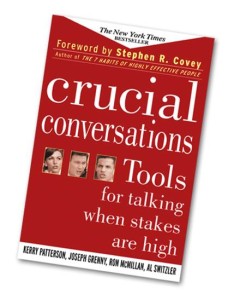
Concept of silhouetted figures with intertwined thought lines in a therapy session setting
Crucial Conversations: Tools for Talking When the Stakes are High
Crucial Conversations is one of the most influential books on both my personal and professional life and I am so happy to share it with all of you. Back in 2007, my mentor enrolled me in a two-day Crucial Conversations course and I was not happy. I thought it would be a complete waste of time (like I had more important things to do). Of course, I was entirely wrong.
 In the workplace, there are many difficult topics we are confronted with everyday – perceived resistance to change, lack of follow through on commitments, issues surrounding quality of work products, perceived changes in motivation, inappropriate behaviors such as bullying, harassment and chauvinist behavior, demonstrated disrespect for colleagues, peers and customers, diversion of organizational resources and passive and\or active sabotage to change. There are lots of ways to handle these situations and behaviors – ignore it, threaten people with consequences, involve your manager, talk to everyone about the issue but the person involved, deliver an ultimatum, refuse to discuss the topic because it is uncomfortable for you and so on. The best way to resolve these issues is through a dialogue with the other party.
In the workplace, there are many difficult topics we are confronted with everyday – perceived resistance to change, lack of follow through on commitments, issues surrounding quality of work products, perceived changes in motivation, inappropriate behaviors such as bullying, harassment and chauvinist behavior, demonstrated disrespect for colleagues, peers and customers, diversion of organizational resources and passive and\or active sabotage to change. There are lots of ways to handle these situations and behaviors – ignore it, threaten people with consequences, involve your manager, talk to everyone about the issue but the person involved, deliver an ultimatum, refuse to discuss the topic because it is uncomfortable for you and so on. The best way to resolve these issues is through a dialogue with the other party.
What is dialogue? Dialogue is the free exchange of ideas between two or more people to create a shared frame of reference in order to resolve a problem, challenge or issue in the workplace or at home. In most everyday conversations, we do not need specific conversation skills to navigate the discussion or the skills we have acquired over the years are good enough. However, when the conversation has turned crucial, we need something more to help us remain in dialogue. That is where Crucial Conversations enters the picture and the good news is if you practice these basic skills for no more than ten minutes a day, you can get SIGNIFICANTLY better at navigating a Crucial Conversation.
So what makes a conversation crucial? Below is the definition of a Crucial Conversation from the book.
crucial conversation: a discussion between two or more people where (1) stakes are high, (2) opinions vary and (3) emotions run strong.
A conversation where you have disagreement over what topping to put on your pizza? – not crucial. A discussion at the supermarket about “paper or plastic”? – not crucial. A debate regarding the use continuous integration in a Scrum Team and if the build breaks whoever checked in code last will be responsible for fixing it? – crucial. Talking to a developer about why they disrespect the work efforts of the technical writers and testers? – crucial.
Crucial Conversations is a pretty easy read. It tends to use a lot of common idioms and popular metaphors. For non-native English speakers, some of the language is difficult to penetrate, but I encourage you to persist since the book is full of gold and easy-to-understand examples. While it is a fairly thin book, less than 250 pages, I suggest breaking the book up into three parts.
The first five chapters are the most important. In these chapters you learn how to identify a Crucial Conversation, some common ways people respond in a Crucial Conversation and how to make it safe to talk about anything. If you stop reading here, you are clearly on your way to better dialogues and better outcomes. The second part, chapters six and seven, are about understanding your emotions during a Crucial Conversation, where do they come from and sharing your internal state with others. The final part, chapters eight to twelve, is about helping people share their internal state, moving to action and some wrap up material like FAQ and how to apply the Crucial Conversation skills on your own.
The thing I find most surprising about Crucial Conversations is how suddenly appear. One moment, you could be having a pretty standard conversation about where to go for dinner or reviewing a report before it gets sent to the client and then – WHAM!! – it suddenly becomes crucial. Maybe your face feels flushed, blood is pounding in your ears or perhaps your hands begin to quiver or sweat. Those are all signs that your emotions are involved big time. Or perhaps you have to start a Crucial Conversation to discuss the impact of someone’s behavior on the Team or deal with the fallout from an unpleasant an encounter the day before. You just dread having to walk into that situation.
If there is one concept you absolutely must take away from this book, it comes from Chapter Three, “Start with Heart”, since every Crucial Conversation must answer this question.
“What is it that I really want?”
Imagine my surprise to see such a perfect example of a powerful question embedded within a book on communication. For me, this powerful question has helped me direct both my professional and personal growth since 2007. So many of the choices I have made since 2007 have been directed toward helping me achieve what I really want out of life. I encourage all of you to ask yourself this question and then begin to act in ways that help you achieve both your personal and professional goals.
Bringing this back to Crucial Conversations, it is my experience that people who have difficult and challenging conversations that did not turn out well because they never took the time to ask themselves “What do I really want for this person and our relationship going forward?” They are too wrapped up in the tactics of winning, saving face, not losing or defending themselves (or their Team) rather than thinking about their larger goals – what is it I really want? If you understand what you really want out of a conversation, when the conversation turns crucial you have a way to keep true to yourself and also maintain the relationship with the other people in your conversation.
Take time to read this book and practice the skills outlined in Crucial Conversations. If you have the opportunity to take a training course from Vital Smarts, it would be a good investment of time. Many times larger companies will offer the class through their HR department or even schedule one if enough people ask for it. In addition, in both the ScrumMaster Plus course and the ScrumMaster Bonus Pack, I teach basic Crucial Conversation skills, as well as other essential techniques for staying in dialogue.





